


Janet Jarrell, Executive Director janet@quinteartscouncil.org
Kodie Trahan-Guay, Communications & Media Director kodie@quinteartscouncil.org
Matilda Aide, Program Director matilda@quinteartscouncil.org
Andrew Gray, Graphic Designer drewgraymatters@gmail.com
Kim Lidstone, Bookkeeper qac@quinteartscouncil.org
The Quinte Arts Council is a not-for-profit, charitable organization, registration number 107869448 RR 0001. Published by: The Quinte Arts Council, P.O. Box 22113 Belleville, Ont. K8N 2Z5.
Material may be reprinted only with permission. Umbrella is available in digital format through Issuu. The information contained within is believed to be reliable, but accuracy cannot be guaranteed. We do not assume responsibility for any errors and/or omissions related to submitted content.


A Message from the Executive Director
Spring is here and brings with it new plans, anticipation and hope - we hope you are filled with the same sense of excitement and purpose that drives our mission forward each day. Umbrella is an important part of our programming. The global paper shortage, a lingering consequence of the pandemic, has prompted us to reassess our approach to print media. Your feedback on this matter is invaluable as we navigate these challenges together.
In the heart of Belleville lies a vibrant community full of diverse individuals facing various challenges, including mental health struggles, addiction issues, and homelessness. Read in these pages about the healing power of art as a creative outlet and support system for individuals.
In this edition of Umbrella, we showcase the remarkable work of Fred Rutherford, whose photography captures the essence of our




shared humanity. Additionally, we delve into the profound themes of Truth and Reconciliation through a compelling two-part exhibition at the Art Gallery of Bancroft, underscoring the importance of acknowledging and addressing historical injustices. Furthermore, we celebrate the 65th anniversary of the Belleville Art Association, a testament to the enduring power of creativity and community.
At the Quinte Arts Council, we welcome three talented student interns whose fresh perspectives enrich our organization. Their contributions remind us that learning is a reciprocal process, and we are grateful for the opportunity to mentor the next generation of arts leaders.
In this issue, we listen to the captivating music of local talents Stephen Bruce Medd and Melted Fro. We watch the cinematic vision of filmmaker Luke Sargent. We read the poetry of Jason Heroux and James Sauvage alongside a thought-provoking discussion on AI and writing.


John M. & Bernice
Our commitment to preserving local history and heritage remains, with insightful features on model trains, the legacy of the Marchmont Home, and the historical exhibits at the Hastings Military Museum. Through these endeavours, we honour the past while embracing the power of artistic expression.
We discover Field Trip Fridays, an initiative where our team ventures into the community to engage with arts, culture, and heritage firsthand. I invite each of you to join us on this journey of exploration and discovery.
As we embark on this new season, let us reaffirm our dedication to fostering creativity, inclusivity, and resilience within our communities. Together, we will continue to lead in advancing, cultivating, promoting and advocating for an inclusive, vibrant and diverse arts community of the Quinte region.







PARROTT FOUNDATION
QAC programs are funded in part by:
Cover: Fred Rutherford Photography
Back: Paul J Wildlife
Janet Jarrell, Executive Director





2 4 6 8 12 16 18 20 22 24 26 28 30 32 34 36 38 40 42 43 44 46 Message from the Chair + Contributors The Future of Umbrella Arts Education Meet our students Photography Fred Rutherford Fine Arts Truth and Reconciliation BAA 65th Music Stephen Bruce Medd Melted Fro Permorning Arts Arts programming at Centennial Secondary School Film Luke Sargent Literary Artificial Intelligence and writing Jason Heroux poetry Heritage Model Trains Marchmont Home Hastings Military Museum James Savage Quinte Arts Council Field Trip Fridays Art Therapy The healing power of art Members Donors In Memoriam Howard Pulver Artist to Watch: Anna Fraiberg Sponsored by the Bay of Quinte Regional Marketing Board Table of Contents Briana Godden
Embracing the Arts: A Message from the Board of Directors Chair
Dear Quinte Arts Council Members and Community,
As we welcome the vibrant season of spring, I find myself meditating on the promise of growth and renewal. With extended daylight, we witness the earth's transformation and are reminded of the power of resilience and the beauty of new beginnings. Let this season’s spirit of abundance fill your creative spirits as you write, sculpt, paint and imagine.

I look forward to connecting with our QAC members in-person during the Annual General Meeting, scheduled for June 13th, 2024. One significant aspect of this year's AGM will be the voting on new bylaws, which will shape the framework for our organization's operations moving forward. Your active participation in this process is vital as it ensures that our governance structure remains robust and responsive to the evolving needs of our community.
Additionally, I would like to extend an invitation to all members who are passionate about the arts and dedicated to the QAC’s mission to consider joining our esteemed Board of Directors. At this time we are looking to appoint two additional members with experience working in fund development and legal services. Serving on the board provides a unique opportunity to contribute to the strategic direction of our organization and play a direct role in shaping its future. We welcome individuals from diverse backgrounds and perspectives, as we believe that a broad range of voices enriches our decision-making processes and strengthens our community.
As we embrace the spirit of renewal that accompanies this season, let us recommit ourselves to the values that define our organization: advancing, cultivating, promoting and advocating for an inclusive, vibrant and diverse arts community in the Quinte region. Together, we have the power to cultivate a vibrant cultural landscape that inspires, educates, and enriches lives.
Warm regards,
Brit
Contributors







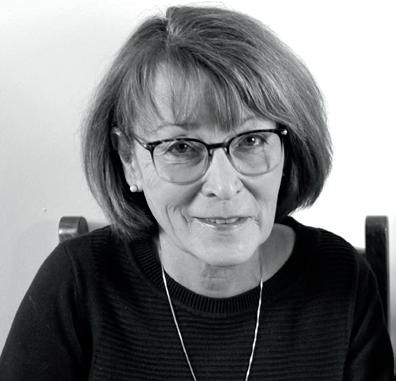
02
Brit Johnson
Abena Green
Kodie Trahan-Guay
Ardith Racey
Greg Ceci
Jennifer Shea
Janet Jarrell
Paul Kite
Richard Hughes


The future of Umbrella
By Janet Jarrell Ash Murrell
History
Since 1991, readers have come to rely on Umbrella for articles and news about emerging and established artists working in the performing, visual and literary arts. We also highlight news and information about arts education and activities in the schools. Published seasonally, Umbrella offers the best editorial and information about arts and culture in the Quinte region.
The QAC has every issue on record, as do our local archives and the National Library and Archives in Ottawa. Taking a deep dive into the history of Umbrella, you will see it evolve from a four page, black and white tabloid newspaper into the beautiful, full-colour magazine it is today.

“There have been many programs and services offered by the Quinte Arts Council (QAC) since its inception in 1967. But the most enduring and successful of them all is Umbrella.” writes Carol Bauer, former editor and producer of Umbrella who worked with Jan Dolby and Peter Davis on the original issues.
Production
Production of this magazine is a year round process. Beginning with conceptualization, planning of editorial, assigning content to local writers, to the editing, design and layout, printing and distribution; production is a full time job. As soon as we begin marketing and promotion of the current issue, the entire process begins again for the upcoming issue.
The team has always understood the importance of Umbrella and the value it presents to the community. The printed copies were mailed to members, and distributed throughout the local communities from Bancroft to Prince Edward County, Brighton to Napanee and all of the communities in between. This is a very large distribution jurisdiction and we were always grateful to the many volunteers who made this widespread distribution possible.
Global paper shortage
In 2020, when the spring issue was printed, the world was on a global lock down, making distribution virtually impossible. We had to pivot - remember
that overused word? Umbrella could be found in local grocery stores - one of the few retails open to the public. The QAC began to use a digital platform (Issuu) in order to ensure Umbrella was reaching its audience - and it did. Umbrella saw an increase in the audience to include provincial, national and even international readers - Umbrella went GLOBAL!
The world experienced the ebbs, flows and challenges of shopping to get their needs and, understandably, many turned to online shopping. Online offers safe shopping and contactless delivery to your doorstep.
According to Statistics Canada, “After a sharp increase at the onset of the pandemic, retail e-commerce sales have receded as of July 2022 but remain well above pre-pandemic levels. The share of retail e-commerce sales, as a proportion of total retail sales, rose from 3.9% in 2019 to 6.2% in 2022 (July year to date). During the height of the pandemic in 2020 and 2021, the shares of retail e-commerce sales were 6.6% and 6.9%, respectively. The retail e-commerce share of total retail sales peaked in 2021, as retailers were impacted by a second wave of store closures during the first half of that year.”
All of these home deliveries required cardboard boxes; there was soon a high demand for boxes in order to keep up with the increase in online shopping. These boxes are made from heavy duty papers created from tree pulp - the same papers
04

used to print Umbrella magazine. With the increase in demand for boxes, paper mills and paper producing companies turned to producing more boxes instead of paper. Even before the pandemic, with the move to digital communications, paper use was on the decline. When the pandemic hit, many paper mills had already started to shut down. This eventually led to a global paper shortage.
The QAC began to see an increase in printing costs by 2021 (costs doubled) and 2022 (costs tripled). We did what we could to mitigate these new expenses. By 2023, the costs had quadrupled which led to a financial loss to the QAC. The Board of Directors and the team had to reevaluate our Umbrella programming. It was clear we could continue production supporting local writers, artists
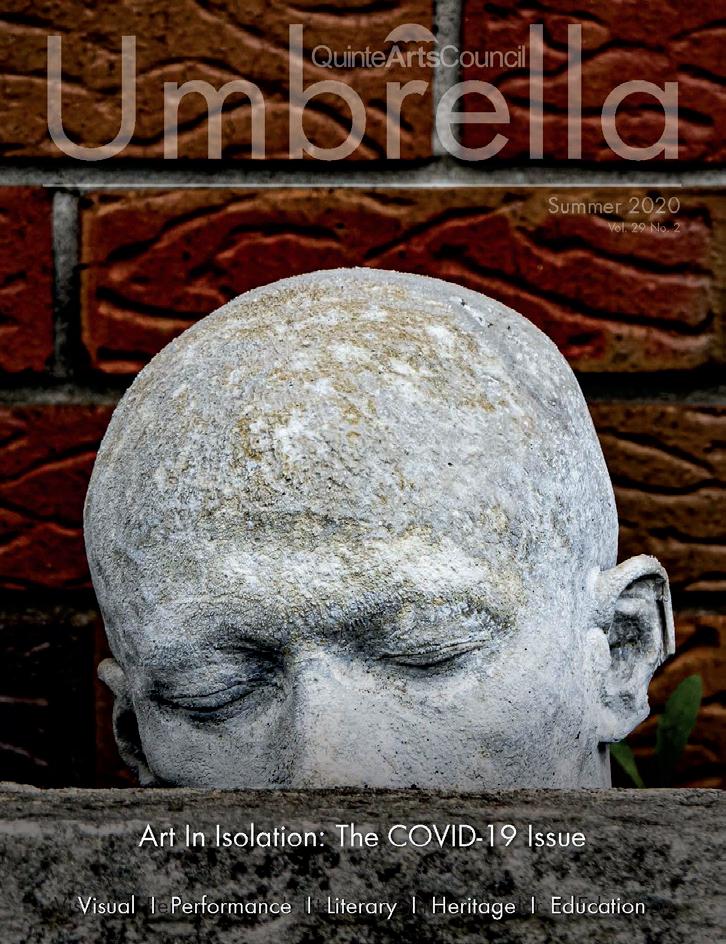
and graphic designers, and publishing the digital issues; we just could not afford to continue printing physical copies of Umbrella under the current work plan.
Is Umbrella still an important program?
In every survey we have on record since the 1990’s, the community has rated Umbrella as the most important program offered by the QAC. It is time to ask you again, ‘is Umbrella important to you?’
Your Opinion Matters!
We need YOUR voice to help us understand the significance of the Umbrella arts and culture magazine. Further, you will help us understand the importance of physical copies of the magazine. By taking just a few moments to complete our brief survey, you'll play a crucial role in shaping the future of Umbrella programming. Your insights will guide us in our decision making process and reflect the diverse interests and passions of our community.
Whether you're an avid reader, a devoted supporter, or someone who's curious about the impact of arts and culture on our community, your perspective is invaluable to us.
Take the Survey Now!
Click here
Thank you for being a vital part of this journey!




05

Meet our students
By QAC Team
Mentoring students at the Quinte
Arts Council plays a pivotal role in nurturing the next generation of artists and creatives. By providing opportunities, guidance, and support, mentors not only impart valuable skills and knowledge but also instill confidence and a sense of belonging in young artists.
Moreover, mentoring fosters a sense of community, creating opportunities for collaboration, networking, and skill-sharing
among students and established artists alike. This sense of community is essential for fostering creativity, innovation, and personal growth in aspiring artists, as they learn from the experiences and perspectives of their mentors and peers.
Ultimately, mentoring students at the QAC not only enriches the lives of individual students but also contributes to the vibrancy and diversity of the local arts scene, ensuring its vitality and relevance for generations to come.
Moyosore “Moyo” Adeyinka (he/him) is a talented Nigerian visual artist with apraxia of speech. He expresses his passion through portraits and other visual works of Arts. He works continuously to explore opportunities to advance his skills. Moyo is currently enrolled in the CICE program at Loyalist College in Belleville and has recently joined the QAC team as a student intern.

06 Arts Education
Moyosore “Moyo” Adeyinka

Tara Geall (She/Her) is a talented young actress, who is currently enrolled in the Arts Program at Centennial Secondary School. She is a CO-OP Student, completing her placement with the Quinte Arts Council. Throughout high school, she has dedicated herself to artistic pursuits, including theatre participating in a few productions such as “16 in Ten Minutes or Less” and soon “Annie Jr.”
Mary Mejias is a visual artist embarking on an exciting career transition to graphic design. With a profound passion for art, she eagerly anticipates blending her accumulated skills as a visual artist to produce captivating designs as a freelance designer. Presently enrolled at Centennial College, Mary has taken a significant step by joining the Quinte Arts Council team as an intern, aiming to enrich her knowledge and experience in the world of art and graphic design.

07
Arts Education
Mary Mejias
Tara Geall


Fred Rutherford
By QAC Team
Fred Rutherford is a landscape and portrait photographer based in Corbyville. He loves how through photography he can capture the events in a life, both large and small. Photography allows for history and memories to be shared for generations. He believes we are surrounded by natural beauty and interesting people and loves to use his camera to document the world.
“I’ve loved taking pictures my entire adult life. Educated in graphic design, I am always striving for the perfect composition that captures the magic of a moment. I am located in South Eastern Ontario and travel throughout the province.”
04
08
Photography


09
Photography

10
Photography

11
Photography


Representing Truth & Reconciliation through art in Bancroft
By Jennifer Shea

Robin Tinney is an Algonquin artist who co-curated two separate art shows at the Art Gallery of Bancroft (AGB) in the fall of 2023: “Truth” and “Reconciliation” in an effort to broaden awareness about both perspectives.
10 years ago, Tinney had curated an art show at the AGB called “Critical Mass” featuring artwork from six Indigenous communities. “I spent the better part of 14 months reaching out to different Algonquin communities and trying to get artists involved. I had no budget at all. It was a matter of asking people for favours.” The show was highly successful, breaking both attendance and sales records at the gallery.
their artists. “Art supplies are not cheap, and these are communities that have very little in the way of excess money. I wanted to make sure that that was not an issue; if somebody needed extra money to buy a canvas and some paints, we could make that happen.”
“It was asking them to trust me. I wanted to have impactful artwork, but I wanted the artists to be comfortable in what they were creating.”
Diane Hannah, Generational Trauma
For the fall 2023 shows, Tinney was able to obtain a grant from Indigenous Tourism Ontario. He offered some of the funds to each Algonquin community for
Tinney decided to separate the exhibits into two so that the messages of truth and reconciliation could be more powerfully
12
Photography
Fine Arts
Bancroft

received. “I envisioned it as two separate shows to make sure that people understood that it’s not one thing. You have to acknowledge and accept the truth of what happened and continues to happen, and then, how do we fix that? They are two sides of the same coin, but you need to know that there are two sides.”
The works of Indigenous artists were featured in the “Truth” show and non-Indigenous artists in the “Reconciliation” show. The shows ran back-to-back.
Once again, it proved challenging to get Indigenous artists on board for the “Truth” show. Tinney was asking the artists to represent their own perspective of living as an Indigenous person in Canada, and this could be a risky endeavour. “It was asking them to trust me. I wanted to have impactful artwork, but I wanted the artists to be comfortable in what they were creating.”
“In the end, the artwork that was selected ran the gamut from being real -
ly in your face pieces to others that were much more tender in what they saw as the truth of living in Canada,” says Tinney.
For the “Reconciliation” show, it was also a bit challenging to generate artworks. “The artists themselves were all in different stages of awareness. There’s very little lived experience in terms of reconciliation. I was encouraging artists to think about it.”

13
Fine Arts
Shank Melinda, Time Immemorial

Tinney is a carver and, since many of the artworks for the two shows would be paintings, he recruited Algonquin artist (painter) Rocky Green on board as co-curator. The AGB was filled for both exhibits, with 16 artworks in the “Truth” show and 15 artworks in the “Reconciliation” show.
“Bancroft is the quintessential smalltown Ontario hub for many local artists whose exhibited work has usually focused on the apolitical and decorative, mainly landscape and wildlife art,” says Molly Moldovan, AGB chair and head of curatorial. “It might be the last place you would expect to find powerful artistic statements on political hot-button topics.”
“And yet … these two exhibitions broke all attendance records for the AGB’s 41 years of existence, with

over 200 attending the opening reception for “Truth” and 125 for “Reconciliation.” We also had more class visits with students from our region than ever before. The feedback from all attendees was unwaveringly positive.”
Tinney is pleased with the impact of these shows on the gallery, the Bancroft community, the non-Indigenous artist contributors, and, especially, the Indigenous artists who contributed. “I have given some artists an opportunity to actually consider themselves artists. There are now more people in my Algonquin community and other communities who realize they are allowed to express this.”
Tinney is now looking into opportunities to share these two art shows in other communities.
Truth
artgallerybancroft.ca/2023-truth
Truth exhibition artists
Valerie Dawn Chevrier, Aarin Crawford & Trudi Knapp, Sherry Crawford, Lynn Dawson, Diane Hannah, Rhonda Haws, Little Bird, Pamela McElheran, Sarazin Connor, Melinda Shank, Lin Smith, Theresa Soloman, April Warren, Leeann Wilson, and Whitney Area school children
Reconciliation
artgallerybancroft.ca/2023-reconciliation
Reconciliation exhibition artists
Barbara Allport, Ken Balmer, Kelly Beaulieu, Tanya Fenkell, David Ferguson, Carol Giles, Henry Melissa Gordon, Mieke Herman, Carolyn Jongeward, Linda Mackey Lang, Molly Moldovan, Ingrid Monteith, Allan O’Marra, Lynne Vegter and Leilah Nancy Ward
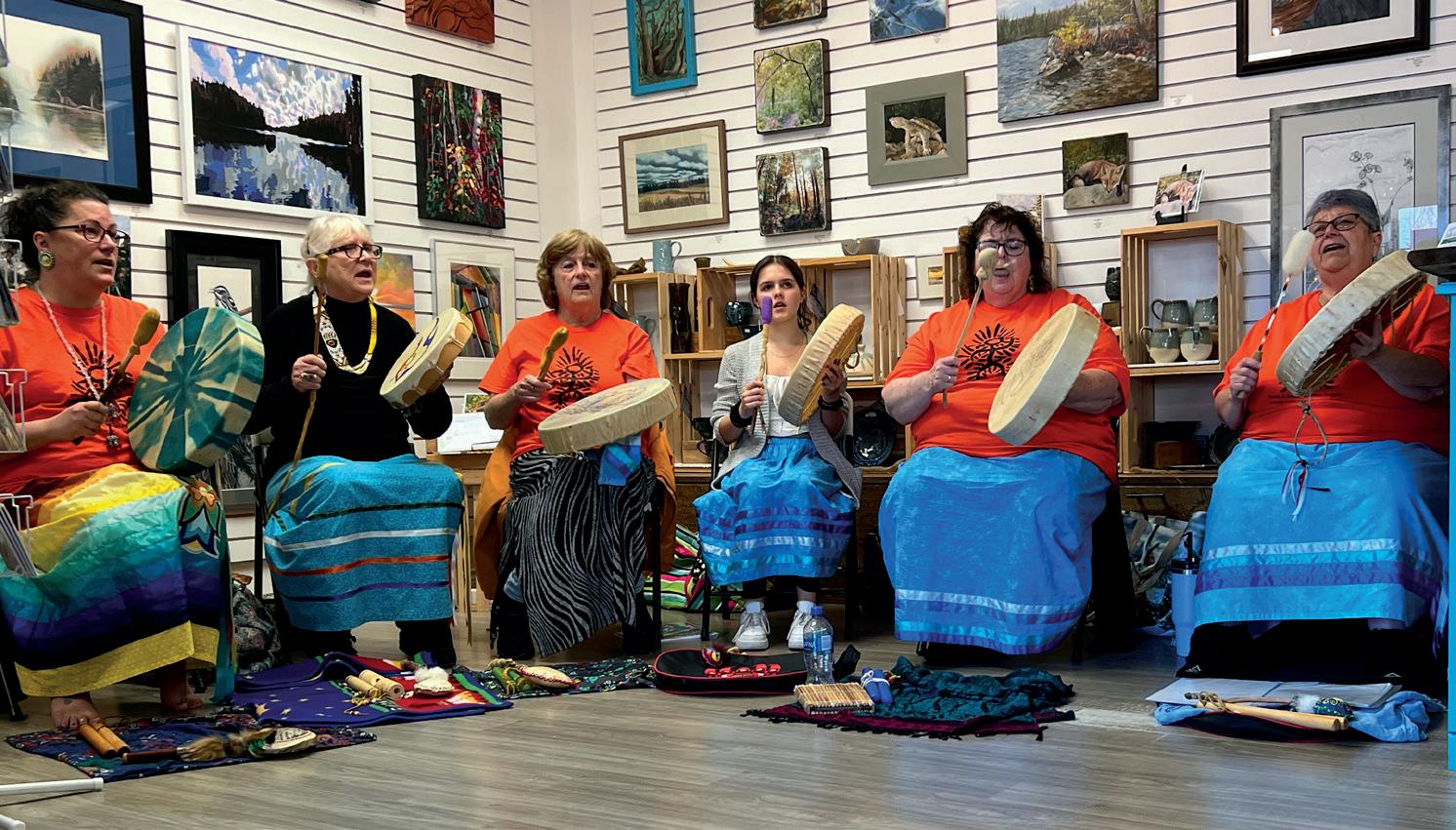
14 Fine Arts
Photography




15
Arts
Fine
Barbara Allport, Life Lost
Linda Mackey Lang, River_Of_Tears
Lynne Vegter, ScalesofInjustice


TFine Arts
Celebrating 65 Years
By Ardith Racey Belleville
he Belleville Art Association (BAA) celebrated 65 years of ‘longevity’ in 2023, and according to Dona Knudsen, what makes it still viable is that “everyone is a volunteer working to create a community of artists.” Located at 208 Front Street in Belleville, the gallery has a goal of selling members' work; however, it’s more about the education and community and less about the commercial push. “The association opened its first physical gallery in 2005, so it’s quite amazing that we’ve been a gallery for 19 years,” says Knudsen, a contributing member.
What’s truly unique about the BAA is that it’s an unjuried gallery. Members pay a small annual fee and are encouraged to submit new original works on a rotational basis. Member Nancy Sherk says that they “currently have about 60 contributing artists and a dozen artisans out of roughly 140 members. Every second Tuesday of the month, there’s a new show. A team of volunteers install the works and try to make the pieces fit together so it’s like looking at a larger painting.” In addition to paintings in various media, the gallery exhibits photography, pottery, jewelry, miniatures, and other artisanal pieces.
In keeping with education and community, the association hosted 15 artist led work shops last year, and those workshops will
continue in 2024. There are studio groups and painting bubbles (a term coined during the pandemic) which meet every week. The gallery space is light and filled with a quiet energy that emanates from the balanced, thoughtful hanging of local art from both new and professional artists. “The willingness of artists to mentor emerging artists and share resources and ideas is a major factor in the group’s success,” says Sherk.
Art Walks, which began in the early 2000’s, are a great opportunity to explore the downtown Gallery District by visiting the BAA, Quinte Arts Council (QAC), Gallery 121 and the John M. Parrott Art Gallery, located on the third floor of the Belleville Public Library. The four galleries are within walking distance to each other and each is unique with its own history and vibe. This year, the BAA will host the 57th annual juried show “Perspectives” at the Parrott Gallery.

16
Nancy Sherk


“Several other artists’ groups have formed in the area out of the idea of supporting artists and having members work together. There’s a camaraderie that reaches beyond painting at the gallery. Small groups paint together on a regular basis sharing ideas and skills which has allowed the association to evolve” says Sherk.
Both Sherk and Knudsen are passionate about the BAA and its dedication to art and artists, driven by their desire to enable anyone to showcase their creative work. Throughout the decades, the association has garnered its support and passion from encouraging ordinary people to put their best work out for others to see. “The association began as a group of mostly women - primarily housewives in the 1950’s - who were dynamite ladies – powerhouses. One of the original contributing members, Joan Reive, used to tell the story that when her kids went down for a nap, she would get her paints out.” says Knudsen.
The association has several sponsored locations where they hang artists’ work. Currently, about 350 pieces hang in various venues such as: The Anchorage, Highland Shores Childrens’ Aid, the Belleville Police Station, Sans Souci, Belleville General Hospital and commercial offices.
The downtown gallery is an exceptional venue, open five days a week, solely thanks to the dedication of its volunteers. Whether you're a professional artist, emerging talent, or simply a lover of the arts, we invite you to drop in and explore what the BAA has to offer.

bellevilleart.ca
Fine Arts
Dona Knudsen
17
Joan Reive
Briana Godden

Songwriting, RollingStone and Avril Lavigne
By Greg Ceci
Stephen Bruce Medd
is a widely known and reputable local songwriter from Napanee who has been crafting songs and spinning stories for as long as we can remember. Originally an exploration geologist in some of the most remote and awe inspiring locations in Canada, he's become a local historian who is most celebrated for his golden voice and repertoire of finely crafted historical ballads and spiritual folk songs. This year marks the twenty-fifth anniversary of his debut album The Quinte Spirit, in which Medd first flexed his songwriting muscles, mentored an aspiring Napanee singer, and was a catalyst in launching her career into the stratosphere of international superstardom.
Medd's first two albums, The Quinte Spirit and MyWindowToYou feature multiple singers but the three songs written for and performed by a then 15-year-old Avril Lavigne garnered the most attention. Medd's poignant and timeless Touch The Sky from the first record was the tune that set the wheels in motion. In 1996, along with Avril's father John Lavigne, as well
as good friend Clifford Trott who's daughter Stephanie was also a featured vocalist, the three musician friends set out to record an album. David Archibald and Duncan Holt rounded out the creative team for both
projects, which Lavigne later used to shop around the industry and land a deal for her first CD.
Medd realized her talent and professionalism when they hit the




 Napanee
Napanee
Music
18

studio to record Touch The Sky. She calmly strolled in and on the very first take, nailed a stunning and memorable performance that to this day sends chills up the songwriter's spine. A random man filming their performances at the CD release in Kingston ended up serving as Lavigne's first manager. She quickly outgrew Napanee and in 2002 recorded her first album Let Go as she spread her wings for flight. In the liner notes, she thanked Medd and his team for believing in her. People began showing up on his doorstep from England, Germany and the United States and he reflects on that exhilarating period of time shortly after Lavigne hit it big, “I had people all over the world contact me. Rolling Stone magazine interviewed me in my kitchen. Even my kids were on YTV because Avril babysat them. Exciting times for sure.”
Medd draws from many influences including Gordon Lightfoot, Pete Seeger, the Beatles, as well as traditional English and Irish folk. Now a seasoned and highly respected songwriter, recording artist and performer, those early times taught him plenty about his craft and the music production process. Medd explains the songwriting impetus from
his first two albums, “I was strongly influenced by the praise, worship and gospel music that Avril's parents were listening to at that time, but the forest and the outdoors are my church and much of my lyric writing is driven by a love and wonderment for nature.”
Medd is set to re-release The Quinte Spirit later this year, with an accompanying concert in the works as well. It's true that Lavigne put Napanee on the map (she was honoured with a star on Canada’s Walk of Fame in 2023) but it is Medd who remains and continues to draw divine guidance from the area's rich history and scenery. The Quinte Spirit has truly stood the test of time, something all songwriters hope for. To be remembered and leave a legacy. Medd has done exactly that as he gazes in the rearview mirror with humility and fondness, “I’m quite proud to know the opportunities I gave Avril helped in her early development. We were all one link in a chain of several links that helped Avril along.”
Search for Stephen Bruce Medd music to view his catalogue, catch a live performance, purchase his music, as well as view those magical videos with Avril in which a star was born.


19 Music

Melted Fro – One Man Band
By Greg Ceci Tweed

Kanye is one of music's
best kept secrets. No, not the Kanye you're thinking of, rather Kanye Calder of Tweed. Calder is the one man songwriting, guitar slinging and melody singing musical force behind the band that is Melted Fro.
The band came together in 2013 and wrote and rehearsed for a full year before hitting the local scene. They test drove their newly minted songs and put them through the paces on a local tour before recording their first album in 2014. The band experienced several line up changes but being a multi-instrumentalist and the main songwriter, Calder eventually took over all duties and continued to record as Melted Fro.
The material is best described as alternative music steeped in rock and blues. Calder's main influences include Queens Of The Stone Age as well as two blues giants, giving him a special affinity for slide. “I play a lot of slide guitar and that all started with listening to Johnny Winter and Elmore James.”
Calder has ten albums of material under his belt, along with an additional release from his side
20
Music
Jai Harvey-Wright

project, Cain Alley. The first video he shot made the airwaves and featured all the women in his family dressed up as witches. Calder explains, “I wrote a halloween inspired album, the main single Candy Apple Heart was featured on Global news. It was really exciting because it was my first time directing a music video.”
Despite overwhelming industry barriers, there's no backing up or backing down for Calder.
His family have been crucial in his evolution as a musician and songwriter, with unwavering support from his entire clan, including both parents and his step-father.
Calder's dad bought him his first drum set when he was seven and his uncle Blair gave Calder his first guitar at ten. However, his most ardent fan was an unlikely one. Calder notes, “My grandma who passed away a few years ago, was a big supporter of the band, even at 75 she would let a rock band play in her basement, stay over after gigs and feed everybody.”
Now, live shows are fulfilled by adding his favourite area musicians Cameron Raynor on drums and Kent Bryanston on bass. Calder explains, “Melted Fro has always been a power trio and the guitar and vocals are the main melodic catalyst.”
Like all songwriters, converting art into financial gain is the big challenge – even for artists like Calder with an extensive catalogue. He laments, “Streaming services should pay artists better. On paper, it seems great to give artists the platform to endlessly upload music but in reality, music has
been devalued on a grand scale since the digital age.”
Despite overwhelming industry barriers, there's no backing up or backing down for Calder. He promises that 2024 will see a new Melted Fro album, as well as another side project. He may only be one man, but he's talented and driven with a second sight and wisdom to see the forest through the trees.

21
Rain Fice
Music
Jai Harvey-Wright
Centennial Secondary School Arts Program Enriches Students’ Lives
By Kodie Trahan-Guay

High school is a time to explore who a person is and what their passions are. Centennial Secondary School has a program for students interested in exploring their passion for the arts. Led by educator Kelly Carrol,l the arts program offers streams for visual arts, music and drama.
Carroll has been teaching at Centennial for 19 years, most of that time has been in the Arts department. She knows how important the arts are for students.
“The arts nurture empathy, cultural understanding, and innovation. They are vital for enriching lives beyond academia and shaping well-rounded individuals who can navigate the world with imagination and sensitivity. I particularly enjoy teaching in an environment where I can collaborate and co-teach with my colleagues, as it allows for a richer and more diverse learning experience for students. Working together with fellow educators enhances creativity, promotes professional growth, and ultimately benefits the entire school community.”
Carroll says that the Arts Program helps to enrich students’ education. It also builds a sense of belonging, at a time when many students are looking to find their place in the community, the arts can provide that home.
The arts program gives students the opportunity to immerse themselves in the arts year-round. They will audition for a major (the artistic discipline the student will focus on for their time during school). The program expands after the first semester to allow students to focus on additional art forms as well and in twelfth grade students can take additional classes like theatre production, drawing, painting, photography, and com-tech to broaden their experiences. Currently the program has space to accept 25 students per discipline.
“Students should choose this comprehensive arts program for the opportunity to share classes with like-minded peers in an inclusive environment,” says Carroll about the program. “They can engage in arts education year-round, and benefit from a wider range of course
offerings in various artistic disciplines. This unique environment fosters creativity, collaboration, and personal growth, providing an unparalleled experience for students dedicated to pursuing their artistic passions.”
Students are able to pursue a “Specialist High Skills Major in Arts and Culture”. This is a ministry funded program that enables students to pursue certifications and a co-op in the arts field, helping to further their prospects for employment after graduation. Carroll doesn’t want students who don’t want to pursue a career in the arts to feel like they can’t join in the program.
“This program is not exclusively for students aspiring for careers in the arts. It is open to anyone interested in the arts, creativity, and collaborating with like-minded individuals. Whether students aim for a career in the arts or simply enjoy expressing themselves creatively, this program provides valuable opportunities for personal growth, skill development, and exploration within the arts and culture realm.”
Performing Arts 22

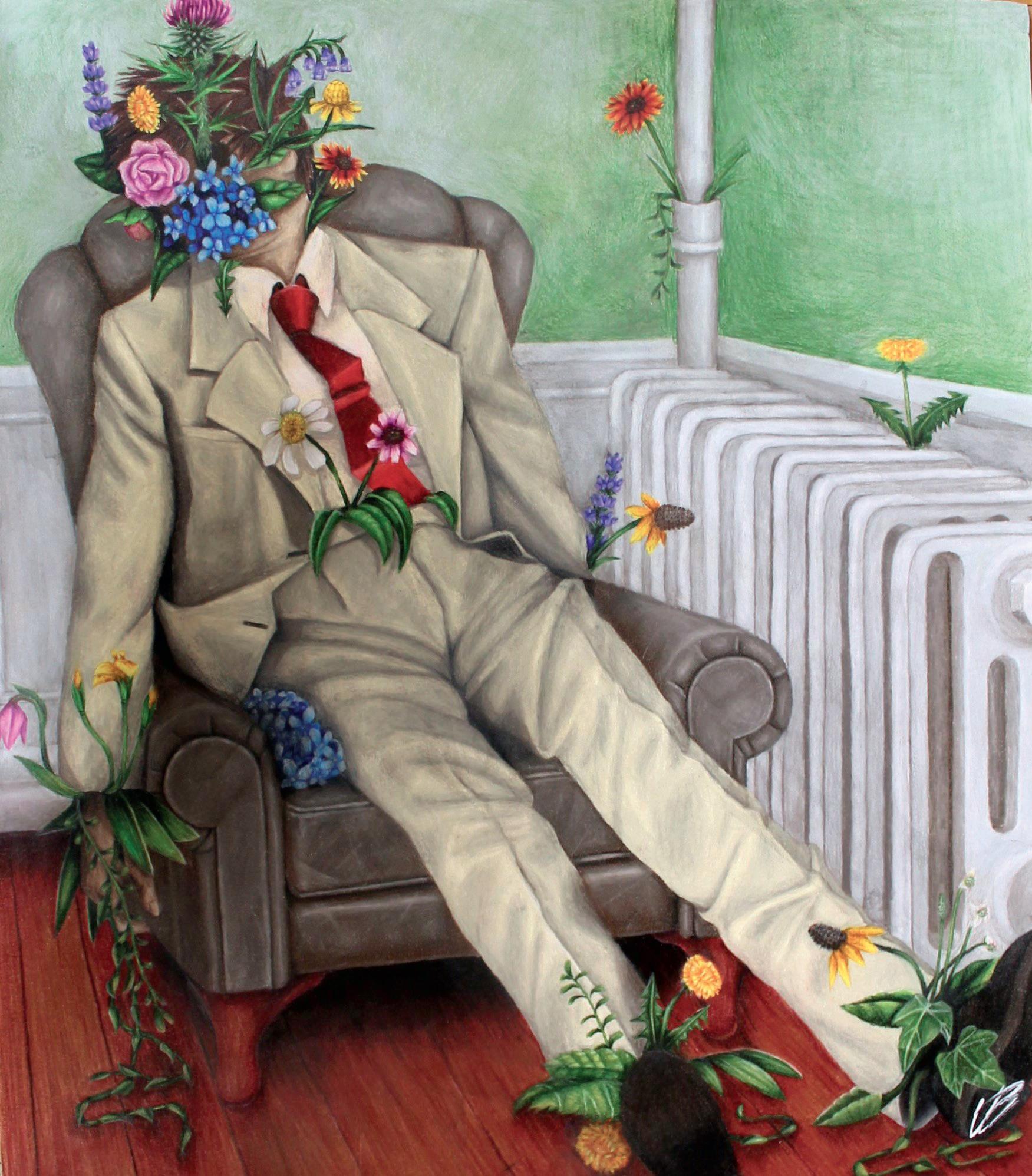
Check out Centennial’s website to learn more about when and where auditions will happen.
Tara Geall is an arts student currently completing a co-op at the Quinte Arts Council. A twelfth grader who is in the drama major, Geall believes that the program has changed her life for the better.
“The Centennial Secondary School Arts Program got me through my entire highschool career, without it I have no idea where I’d be today. I’m graduating in just a few months so I’ve had some time to reflect on what the last four years of my life meant, where I have been, and now where I’m going; this time has allowed me to realize that I most definitely wasn’t always the biggest fan of school and used to count the days until graduation. Now that it’s almost here it’s so overwhelming. Mixed emotions of happy it happened, sad it’s over, and this feeling of what’s next? The Arts Program was an escape from reality on my worst days, and some memories that I’ll never forget on my best.
In grade 9 we filmed Law and Order with a fun spin of the characters all being from children's stories, Grade 10 we did 9 Worst Breakups and Centennial Tonight, Grade 11 was 16 In 10 Minutes or Less and finally my last show in Grade 12 with the program Annie Jr., each show has taught me something new and developed my skills as an actor as well as who I am funny enough playing other people tells you a lot about yourself. To put it lightly and with no exaggeration, it changed my life.
I was accepted into the program in 2020 as a drama major, some of my best friends to this day I had met in the very first class. To me the Arts program helped me through some of the hardest years of my life, from the ages of 14 to 18 you really begin to flush out who you are and have to figure out your path in life, so to have such a warm and supporting community like that helps with personal growth. Over the last four years I have learned, laughed, cried, and sweated for the arts program and I wouldn’t change a thing.”

Arts
Performing
Jack Brown
23
Emma Little

Local editor/director making a mark in the Canadian Film Industry
By Jennifer Shea
Luke

Sargent grew up
in British Columbia. He was an avid movie fan who would watch a movie on VHS over and over until he knew all the lines. As a teenager in Victoria, his dream of working in a video store came true and when he wasn’t working or in school, he was making short videos with his friends and editing them just for fun. It’s no surprise that Sargent now enjoys a career as a film editor and director.
Travelling through Toronto on a backpacking trip, he fell in love with the city and the film industry opportunities it offered. He moved there in 2004 and
volunteered himself into the industry as an editor. His formal education followed. “In my 20s, I went to the Canadian Film Centre (CFC) and that was really competitive. I didn’t get in the first year, which was disappointing, but also a good thing in hindsight.”
“The next year, I applied with everything I had and I got in. I had a wonderful update to my skills and my understanding of the artistry of filmmaking. The CFC was a great landmark for me because I got to see how bigger shows were made and how creative you can be as an editor when you have all those resources.”

His early editing projects were primarily documentaries. His experience at the CFC led to work in indie films, then he moved into television opportunities. “That’s kind of the golden ticket for anyone in the film business because television is working year-round usually. I joined the Directors Guild of Canada, which is what the editors are under.”
Sargent’s television editing work led him to Bruce McDonald, a well-known Canadian director. For the past 5 years, Bruce has been Sargent’s mentor to introduce him to the art of directing. “There’s new, fresh, exciting energy in directing because I haven’t done very much of it. I see it as an opportunity.”
Sargent compares directing to being the host of a great party. “There’s a bunch of different groups of people. You’ve got to go around and make sure everybody’s comfortable and well-fed, and you’ve got to listen to them all. I’m not the best at wardrobe or makeup or hair. What you do is you bring that team together who are the best and you filter ideas. It’s a balance of trust.”
“As an editor, I look at the story more as a finished thing, so I bring that to my directing.”
24
Prince Edward County
Film
Saint Bernard
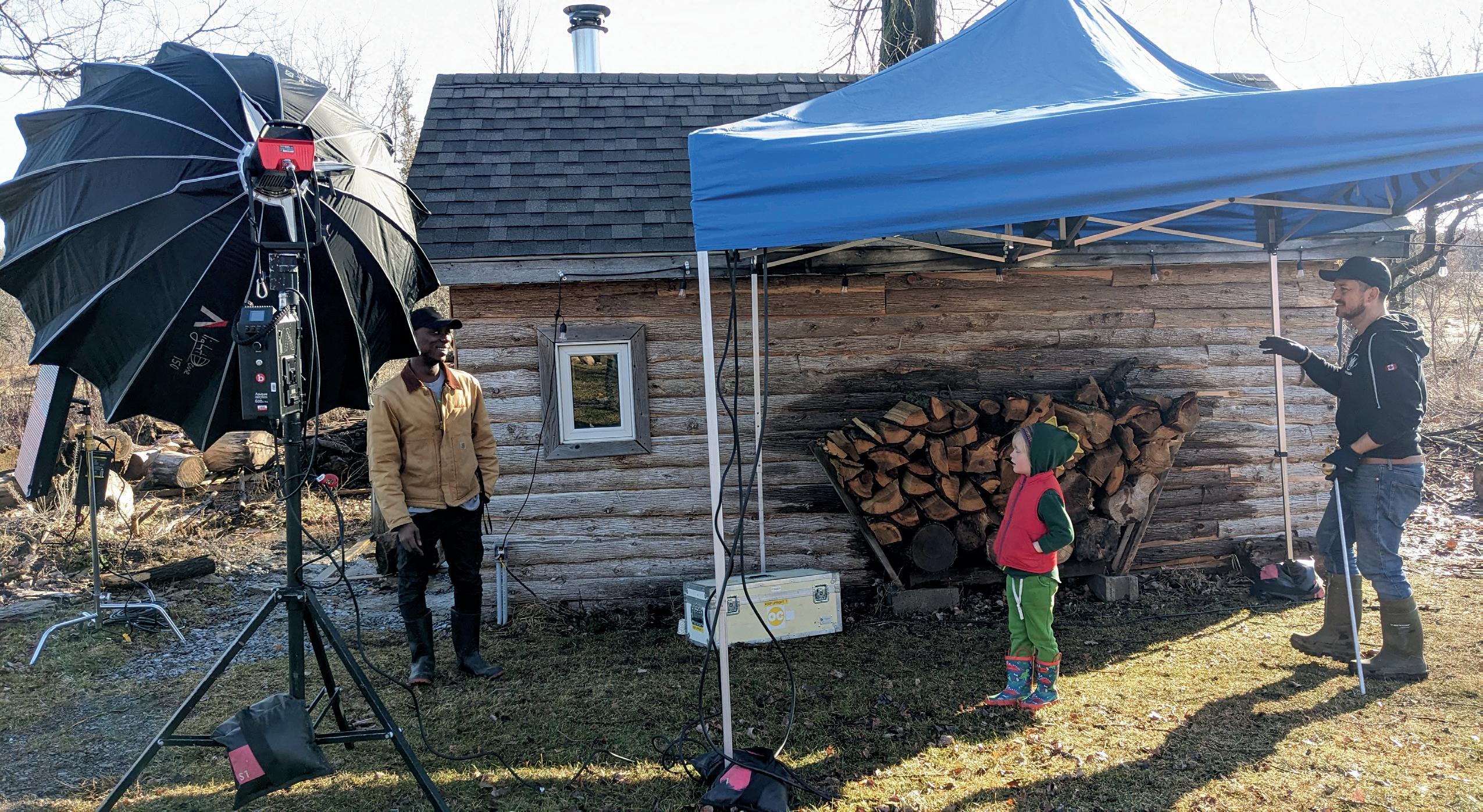
In 2018, Sargent directed his first documentary, The Love Songs of Oedipus Rex for CBC Short Docs. He was director, producer, cinematographer and editor.
His most recent directing project was a short farce/comedy/dramedy film produced in The County, Saint Bernard. Sargent and a small crew and cast filmed the project inside a 7 ft. by 9 ft. sauna. It was a challenge. “For me, that was part of the fun,” says Sargent. “This was literally the box I had to play with, the space I had access to.”
The story revolves around Bernard and a midlife dalliance. “I think midlife is funny because we can't sort of help but become hypocrites while grappling with life catching up to the idea of ourselves ... if that makes sense.”
The key takeaways for Sargent from this project: “That a director should be open to listening for better ideas all the time. The clock rules all things on set, so always be hustling and thinking ahead. Also, trust people, treat them well, and when in doubt, trust your gut.”
Sargent is hoping to premiere the short in the County, possibly at The Regent Theatre. He’s also investigating opportunities to show it at film festivals. “Telefilm has a list of qualifying festivals – a short list – if you’ve made something that goes into one of these festivals, then you can qualify for Telefilm funding for a feature film. I’ve been applying to those festivals.”
He and his young family live in Cherry Valley, Prince Edward County now, but Sargent keeps an office in Toronto and does most of his work there.

25
Lynda Todd Film
Saint Bernard
The power of human storytelling, its quality and originality: AI and writing
By Janet Jarrell
In the summer and fall of 2023, spanning a total of 148 days, the film and television industry found itself at a standstill as the Writer’s Guild of America (WGA) battled with the implications of the use of Artificial Intelligence (AI). This battle disrupted the production of many of our favourite shows and left audiences eagerly anticipating the release of movies, potentially leading to job losses for thousands involved in these projects. Actor allies stood alongside writers, demanding respect in an era increasingly reliant on unregulated AI. The uncertainty surrounding the return of these shows left audiences worldwide in limbo.
However, amidst the chaos, a profound realization emerged – the essential (vital?) role of writers, their creativity, and unmatched talent in the craft of storytelling. This acknowledgment underscored the importance of respecting their contributions, leading the public masses to rally behind the writers' cause.

Every news show and newspaper across the nation was covering this strike action. Editors and publishers were quick to update their submission guidelines, protecting the integrity of their publications and the talented writers that contributed to them. Even the QAC updated its guidelines as we began hearing concerns from our literary community. We are committed to publishing articles written and edited by humans. We reserve the right to reject any submission that we suspect to be primarily generated or created by language modeling software, ChatGPT, chat bots, or any other AI apps, bots, or software.
Where do you think AI goes for ideas?
There is a real fear of AI and what it could do to writers; a major concern is the loss of human storytelling, its quality and originality.
Secondly, writers, editors and other creative professionals being replaced by AI generators. For example, if the industry was to have AI generate a novel and then have a writer adapt it, that would not only deny a human writer the royalties of having their book used for tv or film (and all of the benefits from having that happen: notoriety, future contracts etc), it would also reduce the wages for the writers and editors.
There are ethical considerations with authorship, intellectual property rights, and transparency. Where do you think AI goes for ideas? It scans the internet for, among other things, previously written novels by humans.
If this were permitted, it would devalue writers. Further, the loss of creative control and the impact on diversity and representation as algorithms may be trained on biased datasets.
Thankfully, the outcome was in favour of the writers - for now…
26
Literary


According to the Guardian, “Hollywood writers scored a major victory…in the battle over artificial intelligence with a new contract featuring strong guardrails in how the technology can be used in film and television projects. The writers’ contract does not outlaw the use of AI tools in the writing process, but it sets up guardrails to make sure the new technology stays in the control of workers, rather than being used by their bosses to replace them.”
In a decision that could easily be a model for other industries, “This is the first step on a long process of negotiating and working through what generative AI means for the creative industry –not just writers but visual artists, actors, you name it,” says David Gunkel, a professor of media studies at Northern Illinois University and author of Person, Thing, Robot.

27
Literary
What Moves Us?
By Abena Green

Quinte West
Literary
How does poetry
compare to fishing? In a recent interview with Canadian poet Jason Heroux, OpenEndings,HonestLandscapes,and Surrealism, part of a series known as “What Moves Us,” Heroux discusses his style and process of writing, accessibility of poetry and his poetic inspirations. His works are eclectic leaving the reader both surprised and delighted.
Heroux describes it as surrealism and names James Tate and Russell Edson as
a couple of his influences. He expresses that though his poems delve into surrealism blending “innocence and dark humour”, they are accessible with everyday words and familiar images. It’s the combination of these that makes the final scenes or ideas pop. He says, “It’s the unexpected element that I really respond

to when I read a poem and what I try to do in the works that I create. I want to surprise myself when I write a poem.”
Heroux’s surrealist poems are like those jelly beans that don’t taste like watermelon, cherry and grape but instead like popcorn, earwax, and crushed crickets.
He doesn’t take a lot of space to do this either. You will find some longer poems on the City of Kingston’s website from the time he was the appointed Poet Laureate from 2019 to 2022. Others though, like those in his book, HardWorkCheeringUpSad Machines are only a few poignant lines long. Heroux’s surrealist poems are like those jelly beans that don’t taste like watermelon, cherry and grape but instead like popcorn, earwax, and crushed crickets.
28
Kathryn Archibald
Leah Newhouse

One of the most interesting sections of the conversation was when Heroux discusses how he starts and ends his poems. He described his process with two metaphors, one related to driving and one related to getting a haircut.
Many poets look consciously or subconsciously for a way to tie up the poem with a hard-hitting or catchy final line; looking for a way to end the poem with a “click.” Now, Heroux has freed himself from that pressure and his endings are more discoveries than final destinations. He relates this to getting a haircut - you have a poem, you trim the ending a bit and it adds that extra bounce sometimes.
Even the beginnings of Heroux’s poems can be uncertain, he shares. What helps him get moving is latching onto something in the present moment, often, he says, it’s his environment- the weather, a leaf, a raindrop. He never really knows where the poem is going - where the poet wants it to go, and where the poem needs to go can be two different things.
Heroux describes writing like fishing: you reel something up, maybe it’s something exciting or sturdy that you keep or maybe it’s something that you throw back, and then your line goes back into the water.
If you have not read Heroux’s work before, please make your way to a local bookstore and look for one of his works. Guaranteed, at least one line from one poem will make you chuckle, tilt your head to the side, or scrunch your face before you read it again.
Interested in what Leornard Nemoy has to offer poetry? Tune into the whole interview titled Open Endings, Honest Landscapes, and Surrealism with Jason Heroux on the YouTube Channel, Abena Green. While
you’re there, discover other interviews from the “What Moves Us” series with poets, singers, actors and (soon) dancers.
Jason Heroux is the author of four books of poetry: MemoirsofanAlias(2004); EmergencyHallelujah (2008); NaturalCapital (2012) and HardWorkCheeringUpSad Machines (2016). His most recent book is the novel Amusement Park of Constant Sorrow (Mansfield Press, 2018). Translated into French, Italian, and Arabic, his poetry has been featured in several anthologies, including Best Canadian Poetry in English 2008, 2011 and 2016, and has appeared in magazines and journals in Canada, the U.S, Belgium, France, and Italy. He was born in Montreal, and has lived in Kingston since 1990.

29
Literary
Josh Sorenson

The Belleville Model Railroad Club: It’s like Lego for adults
By Ardith Racey
Anyone who's been
to the Quinte Mall at Christmas over the past 50 years is familiar with the model railroad display.
Kids and big kids love and have loved the snow-covered exhibit with its tiny trains and realistic landscapes. For decades, viewers have imagined horns and bells, the clickety-clack of the wheels on the track, the ‘choo choo’ of the whistle as they ponder the intricacy and art of the train exhibit. It’s mesmerising!
Rick Potter, president of the Belleville Model Railroad Club (BMRC), says “it’s all in the details – it’s the really small things that make the scenes come alive – miniature cows, travellers with suitcases, wooden fences, barns with pigeons on the roof.”
The BMRC celebrated its 50th anniversary in 2023, and they have plans for the future. In fact, Quinte’s 27th Annual Model Railroad Show, a two day event held at Centennial Secondary School in 2023, attracted over a thousand visitors, as well as vendors from London to Montreal, and clubs from Whitby, Coburg, and Brockville. The group spent much of this year working on a new larger travelling layout.
The roughly 25 members share a ‘love of trains and modelling,’ meeting on Tuesday nights at the Bayview Mall. A non-profit organisation with about 20 – 25 sponsors who have their names placed on buildings and train cars, which provide advertising when the group displays their work at other venues.
The layout designs are a group effort. There’s a process of creating the scenery and laying the track which can involve lots
of glue. Potter says there’s a lot of creativity involved and that over the years the parts and technology have changed considerably. “Where we used to be able to only have one train on a track, we can now put ten engines on a track and control them individually, as well as adding realistic sound and visual effects. Good kits are now laser cut which comes with a price and a new knowledge level, and we are also working on becoming more computerised,” says Potter.
 Belleville
Belleville
Heritage 30

The space at the Bayview Mall includes a kids’ layout, a Brio layout, and a permanent display which fills a large room and showcases cities and farmland from Toronto to Montreal. The trains run in a continuous loop through Port Hope, Belleville, Kingston and Brockville, and local sponsors have their names on various buildings. School groups, and kids’ groups such as Cubs and Beavers visit frequently and either control or watch the trains loop the tracks.
The BMRC started in 1972 with meetings at various homes and kept going from there, says Potter. At one time they were located at the Air Force Base in Trenton, and later moved to the VIA Train station; in 2010 when the new train station was built, they were forced to relocate. Potter has been with the group for 30 years – he says that the exhibit at the Quinte Mall belongs to the mall, but the group looks after it. He also welcomes anyone to visit the permanent display.
Whether you’re a kid or an adult, there’s something enthralling about the model railroad exhibits that has resonated with us for half a century. Choo, choo.
bellevillemodelrailroadclub.ca
Photography by Ardith Racey

31
Heritage
The Children of Marchmont
By Richard Hughes Belleville
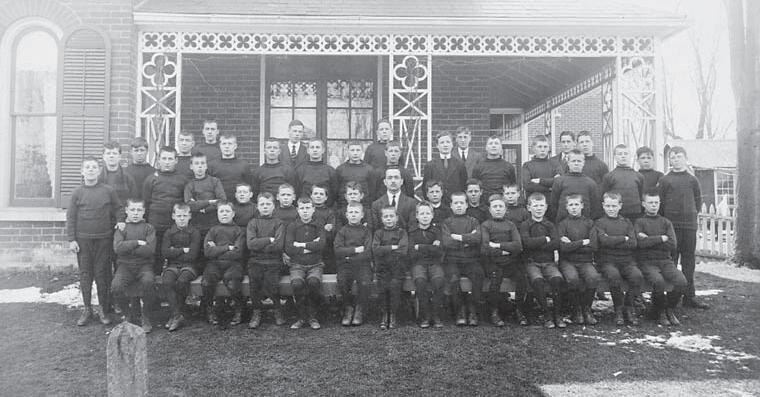
What is the link
between Charles Dickens and the Marchmont Home in Belleville? The answer is a deep concern for the welfare of the orphaned, impoverished and abandoned children, many from destitute families, forced into the crowded streets of the newly industrialized cities of Britain. Through the mid-1800s Dickens wrote 15 novels. He was not simply writing to entertain the upper classes, but as a perceptive social critic, campaigning for children’s rights, education and reform. The stories of David Copperfield and Oliver Twist set in bold relief the terrible state of the teeming urban slums of Britain where thousands of children were doomed to a miserable existence either labouring in factories or derelicts in the streets.
Children eight to ten years of age laboured making match boxes, pasting the sandpaper on the boxes. Other children worked in coal mines and giant factories with long hours and paltry payment. In A Christmas Carol, Dickens lamented that the prisons, Union workhouses and the Treadmill and Poor Laws were still pursuing “their useful course.” The problem of extreme poverty existed across Britain, particularly in the east end of London while the situation in Liverpool was exacerbated by the influx of thousands of impoverished Irish at the time of the Great Potato Famine.
Faced with this disastrous situation, a number of charitable organizations under the leadership of deeply concerned individuals established homes in which

children could receive education and training. Many were relocated to the newly developing countries like Canada, Australia and New Zealand where it was believed they would have the opportunity for a successful life. These individuals devoted their entire lives to this cause. More than 100,000 boys and girls, most between the age of 7 to 14, were brought to Canada between 1860 and 1940 under these programs. The Bernardo Homes brought 35,000 children to Canada. 10,000 children were transported to Belleville to the Marchmont Distribution Home between 1870 and 1925, the boys being placed with local farming families and the girls as domestic workers.
The first small group of children arrived in 1870 under the care of Annie McPherson and were immediately placed on local farms. It was recognized that permanent receiving homes would be required to give the children a place to settle in upon their arrival. That same year, Hastings County, supported by Senator Billa Flint, offered McPherson a home rent-free, the first Marchmont Home, to receive the new arrivals and prepare them for their placements. Marchmont was managed by Ellen Bilbrough. During that year three groups totalling 273 boys and girls arrived. By 1872, the annual arival of chil-
32
Heritage

dren increased to 371 and the flow of children continued for another 50 years. Farmers were informed of the availability of the children and they applied in large numbers. They were required to sign a contract which indentured the child to the farmer until the age of 18 and included arrangements for wages, clothing, food, shelter and work.
In 1872, the first Marchmont Home on Highland Avenue burned; however, the community came together and a very large and spacious house on West Moira Street was purchased by Billa Flint and other supporters and was furnished by the ladies of Belleville. This building, a wooden structure, was destroyed by fire in 1875 and, once again, the people of Belleville raised the funds to rebuild the home, this time using brick and fire-resistant material.
The struggles were indeed difficult for many. The boys, raised in the tumultuous city streets, often small and undernourished, struggled to adapt to the demanding labor of farm work, frequently under harsh masters and facing tasks beyond their training or physical capability. Conditions of life on the farms were primitive, often with little pay or appreciation. Similarly, young girls, unfamiliar with normal domestic life, encountered rough
treatment and extreme work demands in their new homes. Many children endured loneliness, isolation, and often faced prejudice due to their origins when separated from their homelands and familiar places at such a young age.
However, for many home children, their lives in peaceful and secure environments were considered far superior to the impoverished conditions on the streets of industrial Britain, where they were trapped in filth and poverty and constrained by the rigid class system. There were numerous success stories, with former street children receiving a good education and finding love and care in their new families. Many went on to own farms or pursue careers as teachers, doctors, nurses, clergy, tradespeople, politicians, and in other occupations. A significant number also served in the First World War, with many earning commissions and distinctions, and some ultimately returning to Britain.
In the early years, the transportation and placement of children was largely unregulated, in spite of the best intentions of the charitable organizers. By the 1890s, the movement shifted from a religious/charitable philanthropy to be ruled by government programs, regulations and inspections in both Britain and Canada. Child
welfare laws were enacted, including the creation of the Children’s Aid Society.
By 1925, the original operation of Marchmont had transitioned to government programs, as the pioneers of the movement had passed away. That year, after 55 years and having placed 10,000 children, Marchmont closed its doors. The program was amalgamated into the Bernardo organization. It is estimated that about 11 percent of the current population of Canada are descendants of these home children.
The full story of Marchmont is available in the book, Marchmont Distributing Home, Belleville, Ontario, 1870-1925, by James S. Gilchrist through the Hastings County Historical Society.

33 Heritage

Belleville/ Hastings County
Quinte’s Military history comes alive
By Richard Hughes
In the core of down
-town at the corner of Bridge and Pinnacle, lies a massive fortress-like structure known to locals as ‘the armouries.’ One would think this impressive monument was a key, historical asset to our city, and they would be partly right. It is a magnificent, 114-year-old building with a distinguished history; but it is far from being a historical monument. The Belleville armouries is home to an active

Canadian Armed Forces Reserve Infantry Unit - the Hastings and Prince Edward Regiment. It is home to one of our community’s greatest heritage assets - the Hastings and Prince Edward Regiment Museum.
Visitors are able to examine its diverse and comprehensive displays of military dress, weapons, equipment, photos and documents, and most importantly, listen to the museum curator and volunteers knowledgeable descriptions and stories behind the objects.
This museum brings to life in a tangible way the honourable history of our community as it lived through some of its darkest hours. The displays are a testament to the contributions of our own young men and women of Hastings and Prince Edward Counties who gave up the comforts of home and family to enlist and fight great battles in distant places. Our community’s military history goes back to the militias of the early 1800s, particularly
the War of 1812, culminating in the formation of the H&PE Regiment in 1920. Our regiment gained the most battle honours of any Canadian infantry regiment in the Second World War.
The museum plays a vital role in our community by fostering pride in our Regiment and its achievements, while also deepening our understanding of both our historical facts and cultural heritage. It presents a link from the roles of our citizens in some of the most important periods in world history to our community today in
the 21st century. When you can see items from the prisoner-of-war camps and hear their stories, it can be moving. To stand beside the horrific German machine gun of the type that mowed down thousands of brave soldiers is emotional and makes us stop and think.
When you observe items from the prisoner-of-war camps and listen to their stories, it evokes deep emotions. Stand-
34
Heritage


ing beside the horrific German machine gun, the type that killed thousands of brave soldiers, is emotional and prompts us to pause and reflect.
There is a lighter side to the museum relating to the mascot of the Regiment. As the story goes, the original mascot, a massive pewter figure named Little Chief, was quietly “recruited” late one night from the roof of the Canning Factory in Prince Edward County. The mascot accompanied the Regiment overseas. It was lost during the ill-fated Battle of France and the evacuation at Dunkirk in 1940. A large and stately mascot was carved by Abe Patterson of Pembroke and presented to the Regiment in August 1941. It was duly named Chief Petawawa-Much and enjoys special status with our Indigenous peoples. It was smudged by the Mohawks of the Bay of Quinte and taken to the Landing In Sicily day on July 10, 2023 (a day that commemorates the regiment's landing on 10 July 1943 at the beaches at Pacino, Sicily.)
Young people derive particular value from the museum, as the versions of history they've encountered in films, videos, or books take on a whole new perspective when presented physically before them; a reality and a close association with our community, right here in Quinte. It ensures not only a more accurate understanding of history but can inspire young people, arouse curiosity and motivate learning.
Standing before the centre-piece of the museum, the large display model of the Regiment’s battle at Assoro during the Battle of Sicily in July 1943, and hearing a volunteer relate the story of one of the greatest achievements in Canadian military history, is awe inspiring. We have heard many stories of the bravery, sacrifices and daring of soldiers on the battlefield. This Regiment scaled the sheer, 2800-foot mountain at night, in total silence, carrying heavy packs to attack a heavily armed German installation at the summit and achieve their
great victory. These were not just nameless soldiers, they were our soldiers from the towns and farms of Hastings and Prince Edward Counties, affectionately called “plough-jockeys”. The museum brings it all vividly alive.
The Hastings and Prince Edward Regiment Museum is a priceless treasure and a visit is a fully enjoyable and entertaining experience. It opens our eyes to the amazing people and events that form the heritage of our community.
The Hastings and Prince Edward Regiment Museum is open on Tuesdays 10 a.m. – 4 p.m. year-round and also on Wednesdays and Thursdays 1-4 p.m. from May 24 to November 11. Entry is free of charge and through the main armouries door on Bridge Street.
Richard Hughes is the President of the Hastings County Historical Society theregiment.ca
35
Heritage
William James Savage: history through poetry
By Richard Hughes


The arts community
in the Quinte area has long been enriched by talented musicians, actors, painters, and writers. Their performances and creations have greatly enhanced our quality of life, providing countless hours of entertainment and cultural enrichment. It's intriguing to consider how many highly skilled and talented individuals, beyond those whose works have garnered regional acclaim, have chosen to keep their talents hidden, known and appreciated only by their own families.
One glowing example was recently brought to light by the great-grandson of William James Savage whose poetic works had gathered dust on a shelf for almost 100 years. The story of Savage, which is now being revealed thanks to his descendants, is remarkable. Equally captivating are his poetic works, both in style and content.
Who was William James Savage? In many ways he was a very average person
of the Victorian age. Born in Norwich, England in 1879, he left school at the age of 10 and went to work. Savage married in 1902 and with their first child, the young family emigrated to Canada in 1906. His devotion to his new country and the enduring love of his homeland led him to enlist in the military for service in the First World War at the age of 37.
But Savage was by no means an average person. Throughout his life he closely observed his physical surroundings along with the people and events that crossed his path and these clearly impressed and touched him deeply. While some would document their observations and opinions in a journal or diary, Savage displayed a distinct creative nature by expressing his observations on paper through poetry.
His writings began with stories from his childhood in England, his family, teachers, local farmers, the adventures of a
young boy, all set out in colourful, poetic terms. Of his school days he wrote:
“‘Twas there I went and in its turn arithmetic I had to learn. Geography and grammar too were tasks allotted me to do. Those days with pleasure I recall we’d climb upon the old school wall. Eat berries from the laurel shrub as if we’d been deprived of grub. The sweetest apples we could find were situated just behind the picket fence”
What was life like for the Savage family when they arrived in Belleville in the early 1900s? Savage wrote about searching for employment:
“He read the want ads one by one until one caught his eye. Which at the bottom bore these words “No Englishman need apply.”
“His paper then he laid aside, and wandered down the street. The people looked him up and down, who he
36
Heritage


would chance to meet. Two men stood by a hotel door, whose noses and faces were red. And just as he was passing by, one to the other said:
“Another god durned Englishman, whose just arrived in town. To get work that we should have and keep the wages down. They never work in England so they ship them out of there. And dump them down in Canada to be a nuisance here.”
But Savage was not deterred by this negative reception as he wrote in 1915, singing the praises of Belleville:
“I am happy and content for some pleasant times I’ve spent in old Belleville since I claimed it as my home”.
In those days, Front Street stood as the bustling, vibrant heart of the community, a fact not lost on Savage as he wandered its length. His keen observations captured the essence of each business and the diverse characters he encountered, vividly depicted in
his colorful commentary. He starts at the Upper Bridge:
“Now, there is Moore who has monuments, marble and stone. For those who have left us for regions unknown. Fitzgerald cleaning and pressing next door, Will patch up your trousers if they should be tore. Next there is a laundry run by two brothers called Lem. If your garments need washing, just take them to them.”
This vast collection then remained with Savage for almost 50 years until his death in 1964. Ultimately, they were placed in the care of the Community Archives of Belleville and Hastings County. The next chapter in this amazing story occurred in 2019 when Robert Presland of Ottawa was searching his family history and noted that great-grandfather, William James Savage, had gone off to the First World War at the age of 37. This intrigued him; he wanted to find out more about this person.
Through his family, he learned that his great-grandfather had written extensive poetic works and these were preserved at the Community Archives. Mr. Presland contacted the Archives and was able to obtain copies of the handwritten documents. Amazed at what he found – not just poetry but a first-person, eyewitness to his great-grandfather’s life 100 years ago. He undertook the transcription of the “sometimes tortuous handwriting” of his great-grandfather’s works and ultimately, he published them. His book, William James Savage Walk WithMe,From1890toWorldWarPoetry and Prose, presents, in 161 pages, almost 50 stories of Savage’s life from early days in Norfolk, England, through the First World War and daily life in Belleville, with Savage’s distinctive sense of observation and good humour flowing through his own poetic style.
This book is available at the bookstore of the Hastings County Historical Society in the Community Archives, 2nd Floor, Library Building and online at hastingshistory.ca, 161 pages $15.
37 Heritage

The QAC is out on the town!
By Kodie Trahan-Guay Quinte

Join in on the adventures of the QAC Team as they travel around the Quinte area, spreading joy and discovery with their Field Trip Friday series! It's like a treasure hunt, but instead of hunting for gold, they're on the lookout for the best arts, culture and heritage experiences our area has to offer.
Have you ever played "Where's Waldo"? Well, imagine playing "Where is the QAC Team?" as they explore the vibrant downtown Arts District. All within walking distance, stroll through the captivating exhibitions at the John M. Parrott Gallery to the charming showcases at Gallery 121, the Belleville Art Association and don’t forget to stop into the QAC’s very own gallery and cultural hub!
But the best part? You can join in on the fun!
The adventure begins by grabbing a treat at a local spot like Tropical Blends, Sweet Retreat Bakery, and the mouthwatering delights of The Cookie Jar. Then they set out to discover the arts, and spread the word.
38
Quinte Arts Council


You are invited to wander through the downtown core, uncovering hidden gems like Borestski Gallery, Tinkered Decor and Bazar Artisan market, where vintage styles and locally made treasures created by artists can be found.
Their explorations even take them back in time to the Glanmore Museum and National Historic Site, where history comes alive with each step. Taking advantage of their corporate membership, the team has experienced some pretty incredible Glanmore members only events - add link to membership). They travelled to the Quinte Museum of Natural History in Quinte West to Discover the Story of Whales, see some dinosaurs and hear about the partnership with RCI Studios. And who could forget the unforgettable wedding of local comedian Kyle Woolven to The City of Belleville at the stunning Venue 1906?
But the best part? You can join in on the fun! The QAC Team is opening their adventures to local business owners, councillors, and notable Quinte region folks. Want to be part of #FieldTripFridays? Want to be one of their stopping points? Just shoot them an email and get ready for an adventure discovering the many arts, culture and heritage offerings this community has in store for you!

39
Quinte Arts Council

The healing power of Art
By Paul Kite
It's true that some of history's most renowned artists have created their most iconic works during periods of intense emotional turmoil. Vincent van Gogh's masterpiece "At Eternity's Gate" and Edvard Munch's haunting "The Scream" are indeed prime examples of this idea.
Van Gogh's tumultuous life was marked by struggles with mental health, yet his inner turmoil fueled a creative output. "At Eternity's Gate" captures the raw emotion and introspection that defined much of his work, reflecting his connection to the natural world and his own inner demons.
Similarly, Edvard Munch's "The Scream" is an expression of existential angst and despair, reflecting the artist's own struggles with anxiety and depression. The distorted figures and swirling colours evoke a sense of dread and alienation, resonating with viewers on a deeply emotional level.
Art, whether it be dancing, writing, poetry, sculpting, or painting has become a recognized treatment by health
professionals for people dealing with mental health challenges.
It wasn’t until the middle of the 20th century when Adrian Hill (1895 – 1977) a British artist, confined to bed during his convalescence from tuberculosis in 1938 found that making art not only helped pass the time but aided his recovery by relieving and improving his mental state.
The benefits of art extend beyond psychological well-being to include physiological healing.
In 1939 he was asked to return and provide art lessons for injured soldiers and civilians which proved instrumental in aiding their mental recovery during rehabilitation. Adrian Hill served in WW1 at the western front as a soldier and later as a war artist due to his
natural artistic talent. He would eventually complete his art education, write books, and in his later years become an educator and broadcaster. In the years following his convalescence, he pursued his goal to make art a recognized form of mental therapy including the establishment of the British Art Therapist Association in 1964 along with his colleague Edward Adamson who was also a strident practitioner of the use of art therapy.

40
Art Therapy
Kindel Media
Vincent Van Gogh, At Eternity's Gate

Creating art serves as a powerful tool in promoting mental health, regardless of the form, skill level, or outcome of the artistic endeavor. It's the process itself that acts as a catalyst for improving well-being. Engaging in artistic expression has a calming effect on the mind, reducing cortisol levels and triggering the release of dopamine.
When individuals immerse themselves in the creative process, their brains are rewarded with dopamine, leading to feelings of happiness and motivation to continue creating. This positive reinforcement loop fosters a sense of fulfillment and encourages ongoing artistic exploration.
Art provides a unique avenue for communication, particularly for those who find it challenging to express their feelings verbally. Through art, individuals can focus their thoughts and emotions, conveying them in a non-verbal manner that can be deeply cathartic and therapeutic.
The benefits of art extend beyond psychological well-being to include physiological healing. Adrian Hill's work
with wounded soldiers during World War II demonstrated how engaging in artistic activities can aid in the recovery process, offering a holistic approach to rehabilitation.
The early efforts by Hill and Adamson had a profound impact that extended far beyond England. Their pioneering work laid the groundwork for the establishment of art therapy associations in other countries. In 1969, the United States founded the American Art Therapy Association (AATA), recognizing the therapeutic benefits of art in promoting mental health and well-being. Following suit, Canada established its own association, the Canadian Art Therapy Association (CATA), in 1977. These organizations continue to advocate for the integration of art therapy into healthcare practices, supporting research, education, and professional development in the field. In Ottawa, CHEO supports an art therapy program as part of its YouthNet alternate therapy organization and there are many forms of art therapist organizations and accreditation courses around the world.
Creating art, in any form, can provide a meditative calmness, focus, and a mirror to oneself. From understanding a child’s inner fears to battling dementia, art as therapy is proving to be an alternative, holistic and companion course of treatment by health professionals.
The QAC applauds Mississauga Arts Council’s ArtsCare Initiatives Championing the therapeutic value of creative expression.
www.artscare.ca

41
Art Therapy
Laurin Berli
Edvard Munch, The Scream
Members
Business Members:
Chisholm Lumber
McDougall Insurance & Financial
Elevation Audiovisual
Loyalist College
Quinte Gardens
Hawkins Cheezies
Quinn's of Tweed
The Smokin' 116 Bistro and Bar
Young Imaginations
Mr. Print Canada Inc
Advanced Electrolysis Laser
Oeno Gallery
Empire Theatre
Armstrong Glassworks
Cracked Glass Design
CIBC Wood Gundy
Brady Clark Advisory Group
Ontario Dance Academy
Comedy Country
Mind Fusion Visuals Inc.
Your Creative Junction
Quinte Humane Society
Sabrina Jovic and Stan Claus
Peggy deWitt Photography
Back to One On-Camera Actos Scene Study
Melt Studio and Gallery
Quinte Ballet School of Canada
Quinte West Chamber of Commerce
Bel-con Construction
The Lion's Club Belleville
MB deSnoo Consulting Services
Quinte Broadcasting LTD
Starboard Communications
91X Loyalist College Radio
Donors:
Bay of Quinte Regional Marketing Board
City of Belleville
Ralph Johnston
McDougall Insurance Brokers Ltd.
Ontario Arts Council
John M. & Bernice Parrott Foundation
Trillium Foundation
Premier Arts Supporter $1,000+
Loyalist Decorative Painting Guild
Anne Cunningham
Richard Haeberlin and Elaine A. Small
Ross McDougall
Shawn Newman
Audrey Williams
QAC Partner $300+
Kita Beauty Lounge
Maribeth DeSnoo
Maury Flunder
Janet Jarrell
Spenser Lee
Eric Lindenberg
Gary Magarrell and Barry Brown
Rian McLaughlin
Mary-Lynne Morgan
Kerry Munson
Mary O’Flynn
Lola Reid Allin
Rowland & Linda Tipper
Jenny Woods
QAC Benefactor $125+
Chisholm Lumber
Stormy’s Car Sales
Dan & Cathy Atkinson
Hans and Lenneke Buré
Sam and Ann-Marie Brady
Jennifer Chanter
Portia Chapman
Dona Davies
Don DeGenova
Ren & Michiel Duinker
Eugene Lang
Leo and Mary Jo Fortin
Linda and Garry Gray
Bob House
Jen Keilty-Friesen
Manfred and Diana Koechlin
Kim and Glenn Lidstone
Ron and Betty MacDonald
Linda Mazur-Jack


42
Ray McCoy
Ash Murrell
Judith Niedermayer
Susan Nurse
Mary O’Flynn
Rick and Elizabeth Rolston
Lyle and Sharon Vanclief
Susan Walsh
Douglas and Mary Wilson
Hal and Olive Wilson
Manfred and Diana Koechlin
Kim and Glenn Lidstone
Ron and Betty MacDonald
Linda Mazur-Jack
Ray McCoy
Judith Niedermayer
Susan Nurse
Rick and Elizabeth Rolston
Lyle and Sharon Vanclief
Susan Walsh
Douglas and Mary Wilson
Hal and Olive Wilson
QAC Patron $25+
Belleville Concert Band
Matilda Aide
David Alexander
Jeanette Arsenault
Ross Barnett
Judy Bridle
Emebet Belete
Janice Brant
Kendra Butcher
Julie Brown Hale
Judy Bridle
Jana Busse
Bonnie Coldham
Jennifer Chanter
Charlotte Dafoe
Melissa D’Agostino
Donald Desaulniers
Becky Dyck
Leo & Mary Jo Fortin
Melissa Fraser
Shirley A. French
Claire Grant
Joanna and Peter Hoekstra
Catherine Joyce
Alan Langabeer
Suzanne Lowther
Jackson Marilyn
Bob and Cathy McCallum
Judith McKnight
Elizabeth Mitchell
Susan Moyshynshki
Linda Mustard
Sarah Palmer
Joyce Pond
Beverly Pulver
John Smale
Christina Ann Taylor
Lynn Trahan
Geoff Webb
Tara Wilkinson
Lynda Wheeler
Donations in Memory of Howard Pulver
Mary Black
Carol Casey
Kathryn Weston
Donna Knox
David and Mary Milne
Sharon Reid
Mary Tubbs
Linda Grimson
Pamela Dingle
Maureen Kostal
Donors


43
Fred Rutherford Photography

This issue is dedicated to the memory of Howard Pulver 1947-2024
In Memoriam 44


Anna Fraiberg is a marketing professional by day and an avid adventurer/local explorer in her spare time. She rarely leaves the house without her camera, “Just in case.” The best photos always come out of the most unexpected moments.



Content created in collaboration with the Bay of Quinte Regional Marketing Board

































































































 Belleville
Belleville



































